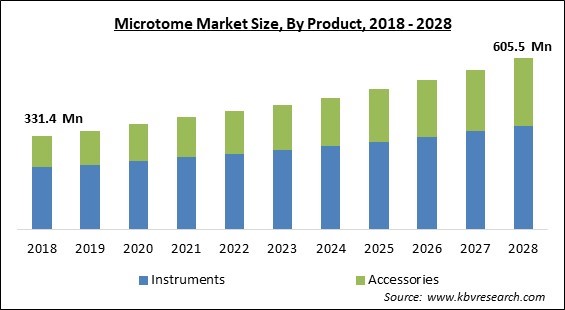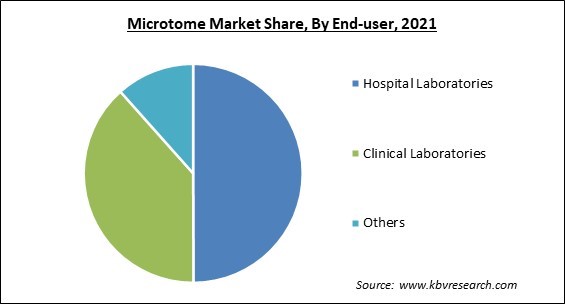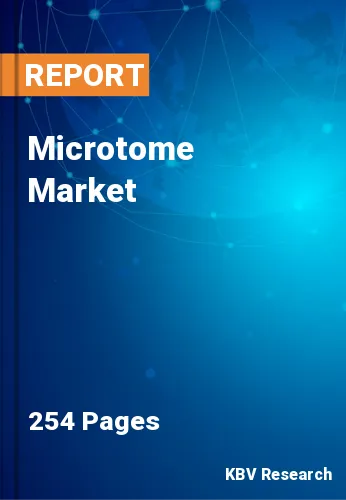The Global Microtome Market size is expected to reach $605.5 million by 2028, rising at a market growth of 6.4% CAGR during the forecast period.
The instrument segment acquired the highest revenue share in the microtomes market in 2021. Rotary microtome, vibrating microtome, and cryostat microtomes are the types of microtome instruments. These instruments are in demand because of their use in hospitals and clinical laboratories. They are extremely useful for diagnosis purposes and that has led to their high demand.

In laboratories, a microtome is sample preparation equipment. Microtomes are used to slice a sample into thin slices that are then processed for examination under microscopes. Samples were manually prepared using knives and razors prior to the development of microtomes. The manual approach, on the other hand, has a limitation in terms of slice thickness. Microtomes allow for the production of samples with a thickness of up to 10 nano microns. An electron microscope can be used to examine such a sample. Body, knife & knife attachment, and material- or tissue-holder are the three essential components of today's microtomes.
According to the GLOBOCAN 2020, there were around 19.3 million new cancer cases recorded in 2020, with the number of deaths reaching 10.0 million. The number of global cancer cases is expected to reach 28.4 million annually by 2040. Increased cancer incidence and increased awareness of early diagnostic methods are two important variables that are expected to raise the usage rate.
Furthermore, rising health consciousness among the general public, as well as increased awareness of the benefits of early identification of such disorders, are propelling the market forward. Other growth-inducing elements include numerous product breakthroughs, such as the creation of laser microtomes that use photons and laser beams to cut through tissues. They allow for precise and repeatable high-quality sectioning while preserving the biological features of the tissues. Other reasons, such as the growing senior population, which is more prone to chronic diseases, as well as significant advances in healthcare infrastructure, particularly in developing nations, are expected to propel the market forward.
The COVID-19 pandemic has had a global impact on the pharmaceutical, diagnostics, and medical industries, especially the microtome sector. The COVID-19 pandemic wrought havoc on people's health and the economy around the world. It has had an impact on entire economies and businesses, as well as individual careers and lives. As enterprises turned their focus away from development prospects and onto adopting exceptional measures to avoid the harmful impact of the COVID-19 outbreak, the stress of maintaining revenue levels at pre-COVID levels has become the new normal. Pharmaceutical and healthcare companies, governments, and the broader scientific community are all working to quantify COVID-19's impact and develop swift, accurate cures in the ongoing fight against the virus.
Cancer is a multi-stage carcinogenesis process involving several pathways that develops into a complex disease. As a result, cancer diagnosis, prognosis, and treatment face a number of challenges. Cancer is the world's second-biggest cause of death, with 10 million fatalities expected in 2020. Cancer is responsible for around 1 in every 6 deaths worldwide. 19.3 million new cancer cases were reported in 2020, with that number predicted to rise to 30.2 million by 2040. The expanding geriatric (according to the World Population Ageing 2020 study, the world population aged 65 and over was 727 million in 2020 and is anticipated to double by 2050 to reach 1.5 billion), as well as the total population, can be related to the increase in cancer incidence.
Precision medicine is a growing field of medicine that takes into account individual differences in genes, surroundings, and lifestyles when treating and preventing diseases. Precision medicine is picking treatments that are completely suited to a patient's ailment and medical history. Oncology has experienced the most development, despite the fact that this technique is extending into all disease areas. The pharmaceutical and biotechnology companies have made major investments in the development of customized medicine during the last decade. Precision medicines presently account for a significant percentage of clinical development income for major pharmaceutical companies like AstraZeneca.

From time to time, the machine must be completely defrosted. Reaction to fixation is slow. It cannot be used on tissues that have been repaired. If the tissue demands a lower temperature than the machine's specified temperature, this feature is useless. The accuracy of morphological details is reduced. Pigmentation is far too noticeable. To the microtomist, dermatitis of the hand and irritation of the nose. Additionally, another big factor restraining the growth of the microtome market is the lack of funding in healthcare in developing and under-developed nations. Unlike, developed countries, where the government spends a fortune on modernizing healthcare and provides citizens with reimbursements, developing cannot afford to do this.
Based on Product, the market is segmented into Instruments (Rotary, Cryostat, Vibrating, and Others) and Accessories. The accessories segment procured a significant revenue share in the microtome market in 2021. Microtome blades, knives, sharing hoses, and other microtome accessories are available.
Based on Technology, the market is segmented into Fully Automated, Semi-automated, and Manual. The manual segment procured a significant revenue share in the microtome market in 2021. Microtomy necessitates a high level of attention to detail that is only available to those who have been trained to value the uniqueness of tissue samples. Visual management is used in manual processing, and it is dependent on the assurance of obtaining high-quality samples. A rotary microtome's manual operation allows for a thorough examination of each specimen.
Based on Application, the market is segmented into Disease Diagnosis and Medical Research. The disease diagnosis segment acquired the highest revenue share in the microtome market in 2021. A microtome is an instrument that is used to cut exceedingly thin material pieces for microscopic inspection. The samples can be examined under transmitted light or electron radiation after they have been diced. The high spending on microtome tools, as well as their critical role in the histological diagnosis of various diseases, are driving the microtome market forward.
Based on End-user, the market is segmented into Hospital Laboratories, Clinical Laboratories, and Others. The hospital laboratories segment acquired the highest revenue share in 2021. The growing number of patient visits to hospitals, the rising number of in-house clinical diagnostic procedures performed in hospitals, growing awareness of early diagnosis, and the provision of reimbursements in developed markets for clinical tests performed in hospitals are all factors contributing to the hospital laboratories segment's large share and fastest growth.
| Report Attribute | Details |
|---|---|
| Market size value in 2021 | USD 396.4 Million |
| Market size forecast in 2028 | USD 605.5 Million |
| Base Year | 2021 |
| Historical Period | 2018 to 2020 |
| Forecast Period | 2022 to 2028 |
| Revenue Growth Rate | CAGR of 6.4% from 2022 to 2028 |
| Number of Pages | 254 |
| Number of Tables | 520 |
| Report coverage | Market Trends, Revenue Estimation and Forecast, Segmentation Analysis, Regional and Country Breakdown, Companies Strategic Developments, Company Profiling |
| Segments covered | Product, Technology, Application, End-user, Region |
| Country scope | US, Canada, Mexico, Germany, UK, France, Russia, Spain, Italy, China, Japan, India, South Korea, Singapore, Malaysia, Brazil, Argentina, UAE, Saudi Arabia, South Africa, Nigeria |
| Growth Drivers |
|
| Restraints |
|
Based on Regions, the market is segmented into North America, Europe, Asia Pacific, and Latin America, Middle East & Africa. The Asia Pacific region procured a significant revenue share in the microtome market in 2021. Due to rising per capita income, the developing medical tourism business, and increased public awareness about the benefits of early diagnosis, this region is expected to experience tremendous growth. There is also growing government expenditure on modernizing and expanding the healthcare sector in the region. This has further propelled the microtome market in the region.
Free Valuable Insights: Global Microtome Market size to reach USD 605.5 Million by 2028
The market research report covers the analysis of key stake holders of the market. Key companies profiled in the report include Danaher Corporation, Cardinal Health, Inc., PHC Holdings Corporation, Boeckeler Instruments, Inc., Bright Instruments Limited, Erma, Inc., Histo-line Laboratories, microTec Laborgeräte GmbH, MEDITE Medical GmbH, and Sakura Finetek USA, Inc.
By Product
By Technology
By Application
By End User
By Geography
The global microtome market size is expected to reach $605.5 million by 2028.
Growth of Precision Medicine are driving the market in coming years, however, High Maintenance and Lack of Affordability in Developing Regions limited the growth of the market.
Danaher Corporation, Cardinal Health, Inc., PHC Holdings Corporation, Boeckeler Instruments, Inc., Bright Instruments Limited, Erma, Inc., Histo-line Laboratories, microTec Laborgeräte GmbH, MEDITE Medical GmbH, and Sakura Finetek USA, Inc.
The Instruments segment acquired maximum revenue share in the Global Microtome Market by Product in 2021, thereby, achieving a market value of $367.2 million by 2028.
The Fully Automated segment is leading the Global Microtome Market by Technology in 2021, thereby, achieving a market value of $331 million by 2028.
The North America market dominated the Global Microtome Market by Region in 2021, and would continue to be a dominant market till 2028; thereby, achieving a market value of $217.3 million by 2028.
Our team of dedicated experts can provide you with attractive expansion opportunities for your business.

